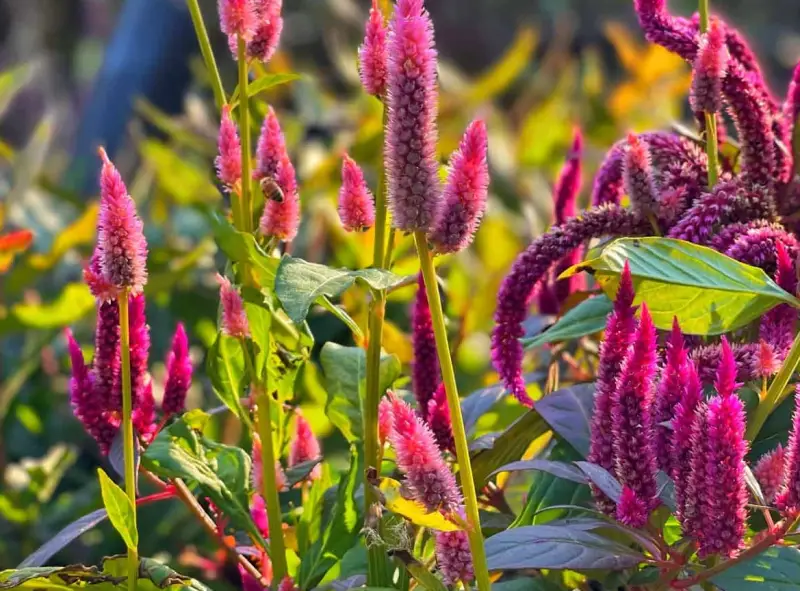Celosia plants are celebrated for their eye-catching, vividly colored blooms that come in a variety of unique shapes, resembling flames, feathery plumes, or coral-like structures. These striking flowers make a bold statement in any garden, attracting pollinators such as bees and butterflies while adding texture and depth to landscapes. Depending on the species, Celosia can be grown as an annual or a short-lived perennial, flourishing in warm climates with plenty of sunlight. Their resilience, low maintenance requirements, and ability to thrive in diverse soil conditions make them a favorite among gardeners of all skill levels.
Whether you’re looking to cultivate Celosia in flower beds, borders, or containers, understanding their specific needs will ensure lush, long-lasting blooms throughout the growing season. In this comprehensive guide, we will explore everything you need to know about planting, watering, fertilizing, and maintaining Celosia plants, helping you achieve a vibrant and thriving garden display.
Overview of Celosia Plant Care

- Botanical Name: Celosia spp.
- Common Names: Cockscomb, Woolflowers
- Family: Amaranthaceae
- Plant Type: Annual or perennial (depending on the climate)
- Sun Requirements: Full sun (6-8 hours daily)
- Soil Type: Well-draining, loamy soil with organic matter
- Soil pH: 6.0-7.0
- Watering Needs: Moderate; prefers moist but well-drained soil
- Temperature: Thrives in 70-85°F (21-29°C)
- USDA Hardiness Zones: 10-11 (perennial), grown as an annual in cooler zones
- Bloom Time: Summer to fall
- Flower Colors: Red, pink, yellow, orange, purple, white
- Uses: Garden beds, containers, cut flowers, dried arrangements, edible varieties in some cultures
What is Celosia?
Celosia is a striking and diverse genus of flowering plants belonging to the Amaranthaceae family, commonly known as cockscomb or woolflowers. These plants are prized for their vividly colored, long-lasting blooms that bring a unique texture to gardens and floral arrangements. The name Celosia originates from the Greek word kelos, meaning “burned,” which aptly describes the fiery, flame-like appearance of its blossoms. Native to tropical regions of Africa, Asia, and the Americas, Celosia plants are often cultivated as annuals, though some species can be short-lived perennials in warmer climates.
Celosia flowers come in a range of brilliant shades, including red, orange, yellow, pink, and purple. Their eye-catching blooms are not only ornamental but also attract pollinators like bees and butterflies, making them an excellent choice for vibrant, pollinator-friendly gardens. Additionally, certain species of Celosia are edible and used in traditional cuisines, particularly in Africa and Asia, where the leaves and young shoots are consumed as leafy greens.
Types of Celosia
Celosia plants are categorized into three main types based on their unique flower structures:
-
Celosia cristata (Cockscomb) – This variety is known for its dense, velvety, and ruffled blooms that resemble a rooster’s comb or a brain-like structure. Cockscomb Celosia is one of the most recognizable types and is commonly used in cut flower arrangements due to its long-lasting nature.
-
Celosia plumosa (Plumed Celosia) – As the name suggests, this type features soft, feathery, flame-like plumes that stand upright, creating a vibrant display in gardens. Plumed Celosia is particularly popular in borders and container plantings, providing a dramatic splash of color.
-
Celosia spicata (Wheat Celosia) – Distinguished by its slender, spike-like flower heads that resemble wheat, this variety offers a more subtle yet elegant look. The blooms often have a gradient effect, transitioning between different hues, and they are highly valued for their ability to add vertical interest to landscapes.
Growing Conditions for Celosia
Celosia is a resilient and eye-catching plant that flourishes when provided with the right environmental conditions. To ensure vigorous growth and an abundance of vibrant blooms, gardeners must pay close attention to sunlight, soil quality, watering practices, temperature, and humidity levels.
Sunlight Requirements
Celosia requires full sun exposure, meaning it needs at least six to eight hours of direct sunlight each day. Ample sunlight is essential for healthy growth, strong stems, and abundant flowering. Without enough light, Celosia plants may become leggy and weak, producing fewer blooms with duller colors. If grown in areas with partial shade, they tend to stretch toward the light, making them more prone to flopping over. For best results, plant Celosia in a location with unobstructed sunlight throughout the day, such as garden beds, borders, or sunny patios. If growing indoors, position them near a south- or west-facing window or supplement with grow lights to mimic natural sunlight.
Soil Preferences
Celosia thrives in well-draining, nutrient-rich soil that supports steady root development and healthy flowering. The best soil type for these plants is loamy and slightly sandy, as it allows for proper aeration and prevents excess moisture retention. The ideal pH range is between 6.0 and 7.0, meaning the soil should be slightly acidic to neutral.
To enhance soil fertility and drainage, it is recommended to amend the planting site with organic matter such as compost, aged manure, or peat moss. These additions improve soil texture, making it more suitable for Celosia’s root system. If the soil is too compact or clay-heavy, mixing in coarse sand or perlite can help prevent waterlogging and root rot. Raised beds and container gardening can also be excellent options for improving drainage while maintaining nutrient-rich soil.
Watering Needs
Celosia plants require consistent but moderate watering, as they prefer slightly moist soil without becoming overly wet. Water deeply once or twice a week, depending on climate and weather conditions, ensuring that moisture reaches the roots. During hot, dry periods, more frequent watering may be necessary to keep the plants from wilting.
It is important to avoid overwatering, as Celosia is susceptible to root rot in soggy conditions. A good practice is to allow the top inch of soil to dry out before watering again. This prevents excessive moisture accumulation while still keeping the plant hydrated. Watering should be done at the base of the plant rather than overhead, as wet foliage increases the risk of fungal infections. In container-grown Celosia, make sure pots have drainage holes to prevent standing water.
Temperature and Humidity
Celosia is a warm-weather plant that thrives in temperatures ranging from 70 to 85°F (21 to 29°C). It is extremely sensitive to cold and should only be planted outdoors when nighttime temperatures remain consistently above 50°F (10°C). Exposure to frost or prolonged chilly conditions can stunt growth or kill young seedlings.
Humidity levels should be moderate, as excessive moisture in the air can encourage fungal diseases such as powdery mildew. If growing in a humid climate, ensure proper air circulation around the plants by spacing them appropriately and avoiding overcrowding. In drier regions, occasional misting can help maintain a healthy moisture balance, but it should be done in the morning to allow leaves to dry before nightfall.
How to Plant Celosia
Successfully growing Celosia starts with selecting the right location, properly germinating seeds, and transplanting young plants at the right time. By following these steps, gardeners can ensure healthy growth and a vibrant display of blooms throughout the season.
Choosing the Right Location
Celosia thrives in areas that receive ample sunlight and have well-draining soil. A site with at least six to eight hours of direct sunlight per day is ideal for promoting strong, sturdy stems and vibrant flowers. Avoid low-lying areas prone to waterlogging, as excess moisture can lead to root rot and fungal diseases. If the soil in the garden retains too much water, consider planting Celosia in raised beds or containers to improve drainage.
Starting from Seeds
Celosia can be easily grown from seeds, making it an excellent choice for gardeners who want to start their plants indoors before the growing season begins. To get a head start, sow seeds indoors six to eight weeks before the last expected frost date.
Use a light, well-draining seed-starting mix and plant the seeds about a quarter-inch deep. Celosia seeds require warmth to germinate, so maintaining a consistent soil temperature of around 70°F (21°C) is essential. Placing the seed trays in a warm, sunny location or using a heating mat can encourage faster germination. The soil should be kept evenly moist but not overly wet, as excessive moisture can hinder seed development.
Germination typically occurs within seven to fourteen days. Once the seedlings have grown a few sets of true leaves, they should be gradually exposed to outdoor conditions through a process called hardening off. This involves placing them outside for a few hours each day over the course of a week, gradually increasing the duration to help them adjust to natural sunlight and temperature variations before transplanting.
Transplanting Celosia
Once the risk of frost has passed and the soil has warmed, Celosia seedlings can be transplanted into the garden or containers. When choosing a planting site, ensure that the soil is loose and well-draining to support healthy root development.
Space the young plants ten to twelve inches apart to allow proper air circulation, which helps prevent fungal diseases and promotes robust growth. After planting, water thoroughly to help the roots establish in their new environment. A layer of mulch can be added around the base of the plants to help retain moisture and regulate soil temperature, particularly in hotter climates.
Celosia Plant Care
Proper care ensures that Celosia remains healthy and produces abundant, long-lasting blooms throughout the growing season. Regular fertilizing, pruning, mulching, and support for taller varieties all contribute to the plant’s overall vitality and aesthetic appeal.
Fertilizing Celosia
Celosia benefits from regular feeding with a balanced, slow-release fertilizer to maintain steady growth and vibrant flowering. A fertilizer with an N-P-K ratio of 10-10-10 or 5-10-10 is ideal, as it provides equal or slightly increased amounts of phosphorus to encourage strong flower production. Fertilizer should be applied every four to six weeks during the growing season to sustain healthy blooms.
It is important to avoid fertilizers high in nitrogen, as excessive nitrogen encourages lush foliage at the expense of flowers. If Celosia is producing a lot of leaves but few blooms, switching to a fertilizer with higher phosphorus content can help redirect energy toward flowering. Organic alternatives such as compost tea or fish emulsion can also provide nutrients while improving soil health.
Pruning and Deadheading
Regular maintenance through pruning and deadheading keeps Celosia looking tidy and encourages prolonged blooming. Removing spent flowers as they fade helps redirect the plant’s energy toward producing new blooms rather than setting seeds. This can be done by simply pinching off wilted flowers or cutting them back with garden scissors.
Pinching off the tops of young plants early in the season can also promote bushier growth by encouraging lateral branching. This results in a fuller plant with more flowering stems. However, for varieties grown specifically for their dramatic height, minimal pruning may be preferred to maintain their striking vertical appearance.
Mulching
Applying a one- to two-inch layer of mulch around Celosia plants helps retain soil moisture, suppress weeds, and regulate soil temperature. Organic mulch materials such as straw, shredded leaves, or bark chips work well for maintaining a healthy growing environment. In particularly hot climates, mulch prevents soil from drying out too quickly and reduces the frequency of watering.
When applying mulch, it is important to leave a small gap around the base of the plant to prevent excessive moisture buildup, which can lead to stem rot or fungal infections. This simple step significantly enhances Celosia’s resilience against drought and weed competition.
Supporting Tall Varieties
Some Celosia varieties, particularly those that grow over two feet tall, may require additional support to prevent them from bending or toppling over. This is especially important in windy conditions or areas with heavy rainfall, where tall flower spikes can become weighed down.
Using bamboo stakes or small garden trellises provides structural support while allowing the plant to maintain its natural appearance. When staking Celosia, it is best to tie the stems loosely with soft plant ties or garden twine to avoid restricting growth. Placing taller varieties in sheltered locations or alongside sturdier plants can also help minimize the risk of breakage.
Common Problems and Solutions
While Celosia is generally a hardy and low-maintenance plant, it can sometimes encounter issues with pests and diseases. Identifying these problems early and taking appropriate action can help keep plants healthy and thriving.
Pests
Several common garden pests can affect Celosia, but they can be managed with preventive measures and targeted treatments.
Aphids – These tiny, sap-sucking insects cluster on the stems and undersides of leaves, weakening the plant and causing distorted growth. A strong spray of water can dislodge them, or an application of insecticidal soap can effectively eliminate infestations. Introducing natural predators like ladybugs can also help control their population.
Spider Mites – These microscopic pests thrive in hot, dry conditions and cause stippling or yellowing of leaves. If an infestation is detected, increasing humidity by misting the plants can discourage their spread. Applying neem oil or insecticidal soap to the affected areas can help control their numbers. Regularly rinsing leaves with water also reduces mite populations.
Fungus Gnats – These small, flying insects lay eggs in damp soil, and their larvae feed on plant roots. To prevent infestations, allow the top layer of soil to dry slightly between waterings. If fungus gnats persist, applying a layer of sand to the soil surface or using yellow sticky traps can help reduce their numbers.
Diseases
Celosia can also be affected by fungal and bacterial diseases, most of which are preventable through proper care and garden hygiene.
Powdery Mildew – This fungal disease appears as a white, powdery coating on leaves, weakening the plant over time. To minimize the risk, avoid overhead watering and ensure good air circulation by spacing plants properly. If powdery mildew develops, applying a baking soda solution or neem oil can help manage the infection.
Root Rot – Overwatering and poor drainage can lead to root rot, which causes wilting, yellowing leaves, and a mushy root system. To prevent this issue, use well-draining soil and avoid excessive watering. If root rot is detected early, repotting the plant in dry, fresh soil and trimming away affected roots may help save it.
Leaf Spot – Fungal or bacterial leaf spots appear as dark or discolored patches on foliage, often spreading in humid conditions. Removing affected leaves helps prevent the disease from spreading. If the problem persists, applying a copper-based fungicide can provide additional control.
Propagation of Celosia
Celosia can be easily propagated through seeds or cuttings, allowing gardeners to grow new plants with minimal effort. Whether starting from seeds or using stem cuttings, providing the right conditions ensures successful growth and establishment.
Growing Celosia from Cuttings
Propagating Celosia from cuttings is a simple and effective way to produce identical clones of a healthy parent plant. This method allows for faster growth compared to starting from seeds and ensures that the new plants retain the desired characteristics of the original.
To propagate Celosia using cuttings, begin by selecting a strong, healthy plant. Using clean, sharp scissors or pruning shears, take cuttings that are four to six inches long from non-flowering stems. Removing any flower buds or blooms ensures that the plant focuses its energy on root development.
Once the cuttings are prepared, remove the lower leaves to prevent them from sitting in water or soil, which can cause rot. The cuttings can then be placed in a container of water or directly into moist soil. If rooting in water, change the water every few days to keep it fresh and free from bacteria. When using soil, ensure it is light, well-draining, and kept consistently moist but not soggy.
Position the cuttings in a warm, bright location with indirect sunlight. Root formation typically occurs within two to three weeks. Once the roots are well developed and at least one inch long, the cuttings can be transplanted into garden beds or individual pots to continue growing. Providing gentle care during the initial weeks after transplanting helps ensure strong, healthy plants.
Growing Celosia in Containers
Celosia is well-suited for container gardening, making it a great choice for patios, balconies, and small garden spaces. When grown in pots, it can provide a vibrant display of color while allowing for easy mobility and care.
Choosing the right container is essential for healthy growth. A pot with drainage holes at the bottom is necessary to prevent excess moisture from accumulating and causing root rot. The size of the container should accommodate the plant’s root system, with at least six to eight inches of depth for smaller varieties and twelve inches or more for taller types.
Using a high-quality, well-draining potting mix is important to ensure proper aeration and moisture retention. A lightweight, loamy mix enriched with organic matter works well. To improve drainage, adding perlite or coarse sand to the soil mixture can help prevent water from becoming trapped in the pot.
Container-grown Celosia requires regular watering, as soil in pots tends to dry out faster than in garden beds. Water deeply whenever the top inch of soil feels dry, but avoid overwatering, as soggy conditions can lead to fungal diseases. During hot weather, more frequent watering may be needed to keep the soil evenly moist.
Fertilizing every four to six weeks with a balanced liquid fertilizer or a slow-release granular option will support steady growth and abundant flowering. If plants appear weak or produce fewer blooms, switching to a fertilizer higher in phosphorus can encourage better flower production.
Placing the container in a location that receives at least six to eight hours of direct sunlight daily ensures that Celosia thrives. If growing indoors, positioning the pot near a south- or west-facing window will provide sufficient light.
Companion Planting for Celosia
Celosia thrives when planted alongside other sun-loving flowers that share similar growing conditions. Choosing the right companion plants can enhance its visual appeal while also providing benefits such as pest control and improved garden health.
Marigolds are an excellent companion for Celosia. Their bright orange and yellow blooms create a striking contrast against Celosia’s vivid red, pink, and purple flowers. Beyond aesthetics, marigolds naturally repel aphids and other garden pests, helping to protect nearby plants.
Zinnias make another great pairing. These flowers have a similar growth habit and bloom in a wide range of colors, complementing Celosia’s unique textures. Both plants thrive in full sun and well-drained soil, making them ideal garden partners.
Salvia, with its spiky, upright flowers, adds structure and height when planted alongside Celosia. The deep blue and purple hues of salvia flowers contrast beautifully with Celosia’s fiery plumes. Additionally, salvia attracts pollinators like bees and butterflies, supporting a healthy garden ecosystem.
Petunias are a wonderful low-growing companion. Their cascading flowers fill in gaps between taller Celosia plants, creating a lush and colorful garden bed. Petunias also help deter harmful insects, reducing the need for chemical pest control.
Overwintering Celosia
Celosia is typically grown as an annual in most regions, but in warm climates, it can survive as a perennial with proper care. Knowing how to protect Celosia during colder months ensures the possibility of regrowth in the next growing season.
In USDA zones 10-11, where winter temperatures remain mild, Celosia may continue growing year-round. Gardeners in these regions can leave the plant in the ground, although trimming back old growth and applying a light layer of mulch around the base can help protect the roots during cooler temperatures.
In colder climates, where frost and freezing temperatures occur, Celosia cannot survive outdoors. It is best to treat it as an annual and replant from seeds each spring. However, container-grown Celosia can be brought indoors before the first frost to extend its lifespan. Place the plant in a bright, warm location, such as a sunny windowsill, and reduce watering to prevent root rot. While indoor conditions may not always encourage blooming, the plant can survive until it can be moved back outdoors in spring.
For those who wish to regrow Celosia without bringing entire plants indoors, collecting seeds from mature flowers is another option. Dried flower heads contain small seeds that can be stored in a cool, dry place and replanted when warm weather returns.
Uses of Celosia
Celosia is a versatile plant with multiple uses beyond its ornamental value. Its vibrant flowers make it a favorite in gardens, floral arrangements, and even culinary and medicinal applications.
Garden and Landscaping
Celosia is a popular choice for adding color and texture to gardens and landscapes. Its striking plumes, crests, or spiky flowers stand out in flower beds, borders, and mixed plantings. Because of its heat tolerance and ability to thrive in full sun, it is well-suited for summer gardens. Celosia also grows well in containers, making it a great option for patios, balconies, and small garden spaces.
Cut Flowers and Dried Arrangements
The long-lasting blooms of Celosia make it a favorite for fresh-cut floral arrangements. The flowers retain their vibrant colors for extended periods, making them a standout choice in bouquets. Additionally, Celosia can be dried for decorative purposes. When harvested at the right stage and hung upside down in a dry, well-ventilated space, the flowers maintain their unique shape and color for months, making them ideal for dried flower arrangements and crafts.
Edible and Medicinal Uses
Some species of Celosia, particularly Celosia argentea, are edible and cultivated as leafy greens in certain parts of the world. In regions of Africa and Asia, the young leaves and tender stems are cooked and used in soups, stews, and stir-fries. Beyond its culinary uses, Celosia has a history of medicinal applications. Traditional medicine systems use Celosia for its anti-inflammatory, antibacterial, and antioxidant properties. It has been used to treat digestive issues, eye infections, and wounds. While its medicinal benefits are still being studied, Celosia continues to be valued in herbal remedies.
Conclusion
Celosia is a low-maintenance, high-impact plant that adds vibrancy to any garden. By providing the right conditions, proper care, and occasional maintenance, you can enjoy a continuous display of its spectacular blooms throughout the growing season.






